For me, the Global Shrimp Forum (GSF) session on black tiger shrimp (P. monodon) turned out to be the most insightful of all GSF sessions. After hearing so many new insights in other sessions focusing on Pacific white shrimp (L. vannamei), the seminar on black tiger shrimp and the future production projections for India and other Asian countries shocked me and made me realize that the revival of black tiger shrimp in Asia may turn out to be the most important trend for the mid-term outlook on shrimp production and trade dynamics.

The resurrection of black tiger shrimp farming is enabled by (1) improvements in domestic SPF shrimp genetics, and (2) establishment of the required infrastructure (BMCs and hatcheries) in important producing countries such as China, India, Indonesia, and Vietnam. Asian shrimp farmers who today struggle to make a living have a way out. Instead of focusing on capital intensive production of Pacific white shrimp, farmers may now switch species and focus on less capital intensive black tiger shrimp production. But will they manage to make black tiger’s revival a success?
The Shrimp Blog is supported by:
- Inve Aquaculture,
- Benchmark Shrimp Genetics,
- Shrimp Improvement Systems,
- SPF Shrimp Feeds,
- Megasupply,
- DSM Animal Nutrition,
- Taprobane Seafood and Verwijs Import,
- Zeigler Nutrition,
- and Grobest.

BREAKTHROUGHS IN DOMESTICATION PROGRAMS OF CPF AND MOANA TECHNOLOGIES PIVOTAL FOR RESURRECTION OF BLACK TIGER SHRIMP CULTIVATION IN ASIA
In his presentation, Robins McIntosh, Senior Vice President at Charoen Pokphand Foods (CPF), described how after its initial rise as a farmed shrimp species, black tiger shrimp was replaced by Pacific white shrimp as the species of choice, but today shrimp farmers in Asia have started to drive a resurrection of black tiger shrimp. The key to their success is that CPF and Moana Technologies (Moana) have persevered after the critical first 5-10 generations of any black tiger shrimp breeding program. Today they have domesticated broodstock and PL that achieve improvements (in terms of growth, survival, and, for example, uniformity) similar to any Pacific white shrimp breeding program. Where most genetics companies stop during this first critical phase of black tiger shrimp breeding programs (as progress is often uncertain and costs to continue breeding programs are high), CPF and Moana persisted.
Image 1: Slide of Robins McIntosh showing the different results between the second and fourteenth generation of CPF’s black tiger shrimp breeding programme
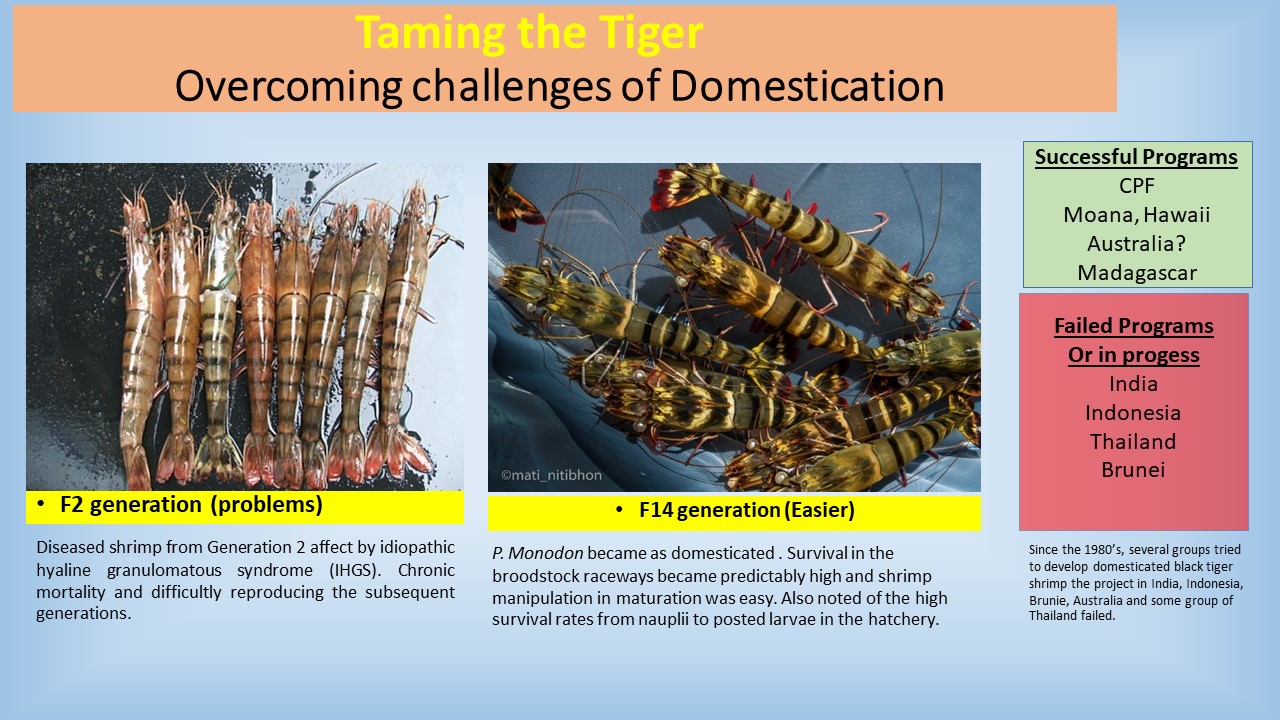
Today, the two companies offer the market relatively fast-growing animals (40-45 grams shrimp in 110-120 days of culture) that are tolerant to diseases such as EHP and APHNS which Pacific white shrimp farmers in Asia struggle with. Although there are a handful of other companies that offer or own domesticated black tiger broodstock, CPF and Moana offer by far the most-advanced breeding programs and dominate the market. The companies’ domesticated black tiger shrimp is best farmed in low stocking densities (10-20 pcs/m2). The ponds in which they are mostly farmed—in countries like India, Bangladesh, and China—only require some degree of aeration. Farmers don’t need to invest in liners, shrimp toilets, and automated feeders, which are nowadays common for more efficient and intensive Pacific white shrimp production. Moreover, operating costs are much lower: for one crop, less feed and other inputs are required in this lower density system. McIntosh therefore calls today’s domesticated black tiger shrimp the “poor farmer’s shrimp.”
Image 2: Slide of Robins McIntosh showing his black tiger shrimp production data
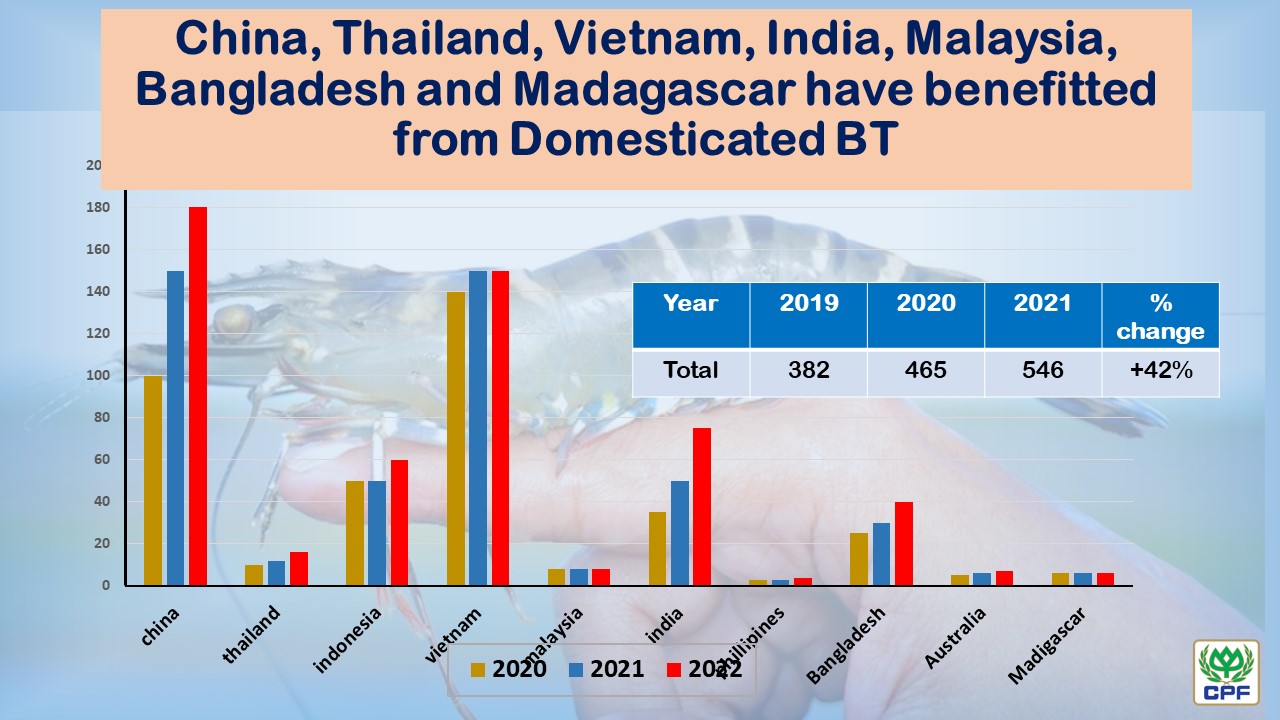
Since 2019, the availability of domesticated black tiger PL has contributed to an increase of production from 382,000 MT to 546,000 MT in 2021 (see image 2). Especially China and India are driving black tiger shrimp production growth. But also other countries, such as Bangladesh, Indonesia, Malaysia, and Madagascar, have already benefitted from the availability of domesticated black tiger PL and have seen a black tiger production increase from semi-intensive producers.
In China, where CPF has an 85% market share of the black tiger PL market and has seen its sales surge drastically, the black tiger shrimp cultivation area increased from 10,000 ha in 2020 to 16,000 ha in 2021. According to McIntosh, farmers report good results in terms of productivity and profits and the success of some encourages increasingly more farmers to switch species. CPF estimates that the total black tiger shrimp production in China increased from 100,000 in 2020 to 150,000 MT in 2021 and 180,000 MT in 2022. This year, China will possibly outgrow Vietnam as the world’s largest black tiger shrimp producer. McIntosh is bullish about further growth over the next couple of years.

VAISHNAVI AQUATECH PREDICTS 550,000 MT BLACK TIGER SHRIMP TO BE HARVESTED IN INDIA IN FINANCIAL YEAR 2026-2027
Dhaval Contractor, speaker at the GSF black tiger shrimp session, co-owns a feed manufacturing business (Ishi Marine Technologies), a shrimp farming operation of 400 ha (Shree Sai Krupa Aquaculture), and a shrimp breeding company (Vaishnavi Aquatech). All of the group’s operations are located in Gujarat, a state along India’s western coast. Only some of its hatcheries are located in Andhra Pradesh, along India’s eastern coast. Contractor’s family business is the main driver and enabler of the resurrection of black tiger shrimp farming in India.
Its feed business is supported by a technical partnership with Zeigler Nutrition, the US-based specialized shrimp feed conglomerate. For its breeding business, the company has teamed up with Moana. Vaishnavi Aquatech started importing domesticated black tiger broodstock from Moana in 2021 and used the animals to produce PL in its hatcheries in Gujarat and Andhra Pradesh. Today, the Contractor family runs 6 hatcheries across the country and has produced more than a billion PL. But the company has a bigger plan.
Video: Vaishnavi Aquatech’s BMC in Gujarat, India.
Source: Vaishnavi Aquatech
Instead of importing adult breeders, the company has invested in a local broodstock multiplication center (BMC) which recently got accredited by the Indian government. When fully operational, this BMC should be the main enabler of further growth of India’s black tiger shrimp production. Vaishnavi Aquatech now starts importing parent PL from Moana in Hawaii and grows those into adult breeders that will produce F1 generation broodstock for Vaishnavi Aquatech’s own and other approved hatcheries. Contractor expects that if its goals are achieved, production will gradually increase from 220,000 MT in financial year 2022-2023 (April-March) to around 455,000 MT in financial year 2026-2027. When he presented this number at the GSF last September, the audience was shocked.

Contractor assumes that the black tiger shrimp cultivation area will grow from 60,000 ha in 2022-2023 to 130,000 ha in 2026-2027 (Image 3). He predicts that by 2023 in Gujarat, the home state of his family business, Pacific white shrimp will only be a niche species. Practically all farmers will switch species and produce one crop annually. He further predicts that gradually a significant number of farmers along the eastern coast—in Andhra Pradesh, but also in the more northern states of Odisha and West Bengal—will switch species. The further south along the eastern coast you go, the more likely that farmers will choose to grow two crops annually.
Image 3: Dhaval Contractor’s predictions about the resurrection of black tiger shrimp in India
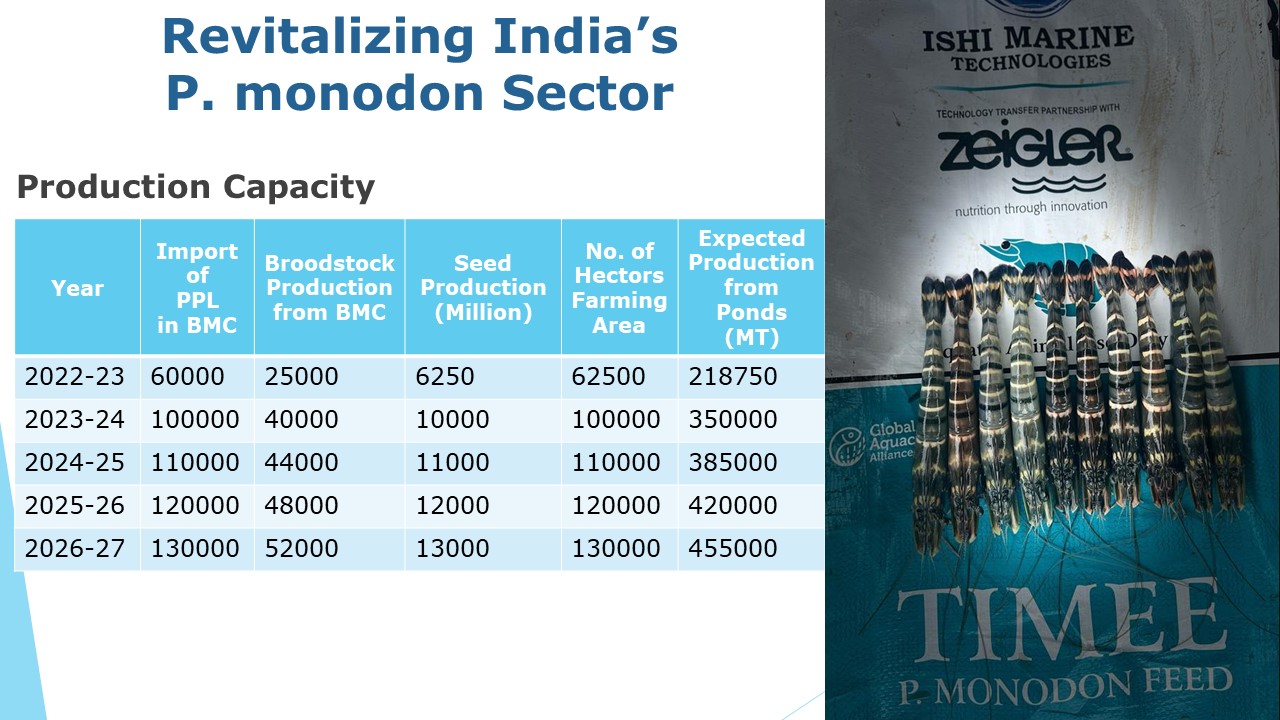
Contractor argues that current production results of farmers using his domesticated PL show that the most successful strategy for farmers is to stock at densities of 10-20 PL/m2. A vast number of the more than 150,000 Indian shrimp farmers lack the capacity to invest in pond infrastructure or to finance the operational costs of the more intensive Pacific white shrimp production. It’s these “poor” farmers, as McIntosh calls them, for whom black tiger shrimp might turn out to be an opportunity to keep making a decent living from shrimp farming in an evolving industry.

DOMESTICATED BLACK TIGER PL WILL BECOME AVAILABLE TO INDONESIA’S SHRIMP FARMERS SOON AS WELL
Moana Technologies also found a partner in Indonesia with big plans to drive a resurrection of black tiger farming in Indonesia. Bong Tiro, co-owner of a group of hatcheries in Indonesia, enthusiastically shares his views.
Image 4: Walter Coppens (most left, owner of Moana Technologies) and Luc Roose with Bong Tiro (middle right) and two of his business partners Ruslan Yassin and Irwan Tandiah (Feb 14, 2020) while signing of MOU between Moana and Tri Karta Pratama (one of the companies co-owned by Bong Tiro) as a sole distributor of MOANA breeders and PPL.

Bong Tiro has been deeply involved in Indonesia’s shrimp industry since 1986. In the early 1990s manage a large black tiger shrimp hatchery that was the main supplier of PL to the large shrimp farm of Dipasana Citra Darmaja (later operated in a satellite model between small scale farmers and CP Prima) which at its top produced 40,000 MT of black tiger shrimp, all from wild-caught broodstock. For Dipasena, the quality and availability and quality of PL was the major constraint and the company hired Bong Tiro to develop its own hatching infrastructure within the mega farm.
Today Bong Tiro is part of a group of companies that operates Pacific white shrimp hatcheries across Indonesia and has big plans to soon being domesticated black tiger shrimp to Indonesia’s shrimp farmers. There are today still large farming areas in Indonesia used to produce black tiger shrimp under extensive systems, especially in Kalimantan, but also in different parts of Sulawesi and Aceh. The total land area under black tiger farming may today still be around 300,000 ha but production will not be much more than 50,000 MT. Without the availability of domesticated PL, black tiger shrimp production in Indonesia won’t be able to grow.
With this in mind, Bong Tiro started to do trials with Moana’s genetics already in 2019. Several farming trials were successfully conducted, both in extensive and in semi-intensive farms. He believes that extensive farmers who today lack productivity due to the lack of availability of PL from traditional source, will be ready to buy his domesticated PL as soon as it becomes available. But even more promising, he also sees good potential to offer semi-intensive shrimp farmers - who struggle with farming Pacific white shrimp - the opportunity to switch back to black tiger shrimp. He dreams about the opportunity to support the government in its ambition to revitalize the extremely large shrimp farms that were previously operating under CP Prima in Lampung by using domesticated black tiger shrimp.
Image 5: Harvested and packed on Semang Island. HOSO black tiger shrimp reared from Moana genetics, ready to be shipped to China in 2019.
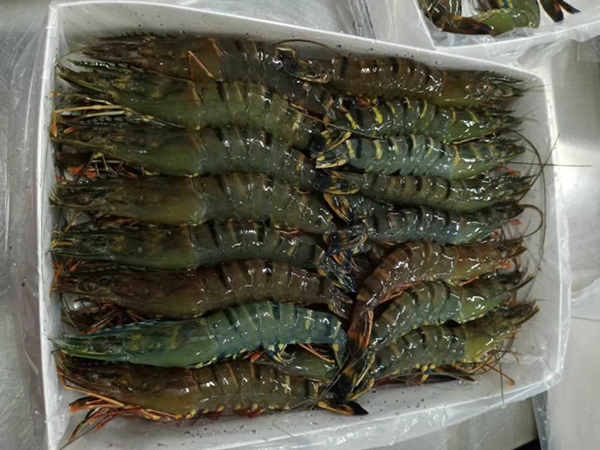
Bong Tiro does not intend to sell breeders and Nauplii to independent hatcheries. Instead, it will focus on leasing and co-producing in existing small and medium-sized hatcheries. This to avoid that other hatcheries claim to produce PL from Moana genetics, but in reality use wild animals. To enable this model, Bong Tiro focuses on building his company’s own infrastructure with small BMCs in strategic areas from where it can supply its own and jointly operated hatcheries.
In 2022, Bong Tiro imported 3 batches of PPL from Moana in Hawaii to its own BMC in Indonesia, of which the first breeders should be distributed to its hatcheries this month. By the end of 2022, Bong Tiro aims to be present with his domesticated PL in three strategic locations in Indonesia. Although he sees an exciting 2023 for black tiger shrimp ahead, he also sees some challenges. He especially sees an important task in also getting Indonesia’s processors on board who will need to help to develop a market and find customers for the black tiger output, but which today still often have a wait and see attitude. Bong Tiro promised me to keep us posted on how his plans develop.

RE-ESTABLISHING THE OPTIMAL FARMER-SYSTEM-SPECIES COMBINATION TO SECURE LIVELIHOODS FOR SHRIMP FARMERS IN ASIA
This brings me to the core of my insight from the GSF black tiger shrimp seminar. As many industry insiders and analysts have been saying over the past two years: the Asian shrimp industry needs to get its act together if it wants to remain competitive to its Ecuadorian peers. Farmers and processors have to work together to ensure the right farmer-system-species match. For some farmers it may entail adopting new technologies that make their systems more efficient. For other farmers it may mean switching to another species that is better suited to the ability and willingness of the farmer to invest.
Since the fall of black tiger shrimp production, in most Asian countries practically all semi-intensive producers shifted to Pacific white shrimp production. For some years, many of the farmers that made the transition have been able to make good profits. However, with supplies ever growing, prices have come down while production costs have been rising. Today, we’re heading to a situation where only the most efficient producers can survive. This includes investing in technologies such as automatic feeders, aeration control systems, and biomass estimation tools, as well as multi-phase farming systems, tanks, and other new systems that require even larger investments. Farmers that have made or will make these investments include many of the corporate farms that are supported by well-educated farm managers, but also smaller scale farmers that are supported by platforms such as Aquaconnect, Aqua Exchange, eFishery, Delos Aqua, Hydroneo, Jala Tech or XpertSea to name a few, or by corporate players such as Minh Phu in Vietnam or Taprobane Seafoods in Sri Lanka, in adopting new technologies and investing in their farm infrastructure.
But a large group of small-scale producers may, for whatever reason, not (yet) be able to adopt these technologies or to make the required investments in the infrastructure of their farms. In the playing field of today’s shrimp farming, for these small-scale farmers the farmer-system-species combination of semi-intensive Pacific white shrimp production may no longer be feasible. Therefore, just like the even more extensive traditional farmers, an alternative strategy to continue making a living of shrimp farming could be for these farmers to start cultivating black tiger shrimp.

WILL THE MARKET SUSTAIN A SURGE OF BLACK TIGER SHRIMP PRODUCTION?
Whether a shift in species is really an outcome for these small-scale farmers will also depend on whether the market can sustain a price level that these farmers need to be able to sustain production. The surge in black tiger shrimp production in China is absorbed entirely by the domestic market which is so far willing to pay that higher price. Black tiger shrimp competes as a premium fresh product in the wet markets with locally farmed Pacific white shrimp. Chinese consumers pay a higher price for the product, considering its taste and appearance as premium features. However, Indian farmers are not in that position. On the contrary, they depend on a highly competitive export market. During the black tiger shrimp session at the GSF, some of the importers participating in the final panel regarding market reflections were worried after learning about the projections of McIntosh, Contractor, Harry Yuli (Atina in Indonesia), and Mr. Le Van Quang (Minh Phu Seafood Corporation).
Image 6: The market reflections panel at the Global Shrimp Forum’s black tiger session with Heiko Len (Lenk Frozen Foods), Rogier Speelman (Fisherman’s Choice) and Mathias Ismail (OSO)

Being highly passionate about the species, people involved in black tiger shrimp cultivation, processing, and exports truly believe that black tiger shrimp is a premium shrimp species. They claim its superiority based on its dark color and pattern, its strong taste and texture, and its extensive (almost natural) production process. Based on these claims, they believe that they’ll always be able to receive a premium price for their products. Although I share their passion for black tiger shrimp, I’ve also seen the harsh market reality and know that only a few markets actually pay a premium for black tiger shrimp products.
One of those markets is France. Mathias Ismail is the owner of OSO, one of the largest producers of black tiger shrimp in Madagascar. During the market reflections session at the GSF, he proudly explained how his company is set up and how they manage to sell their product for three times the price that their clients would pay for Pacific white shrimp. OSO and other major producers from Madagascar, such as Unima, have done a tremendous job in developing a positive market image and premium price position for Malagasy shrimp in the food service industry and retail market in France. There are two drawbacks: (1) the French market for black tiger shrimp is primarily a HOSO market, and (2) the market segment is estimated to be not much larger than 6,000 MT. Outside France, Unima and OSO face difficulties finding customers that are willing to buy at a similar price level. Even if producers in Asia would manage to develop such a market image for their products and compete with producers from Madagascar and e.g. Nigeria (Atlantic Shrimpers and Primstar), the 6,000 MT market size is insignificant compared to their production outlook.
Image 7: OSO's organic shrimp produced in the Madagascar
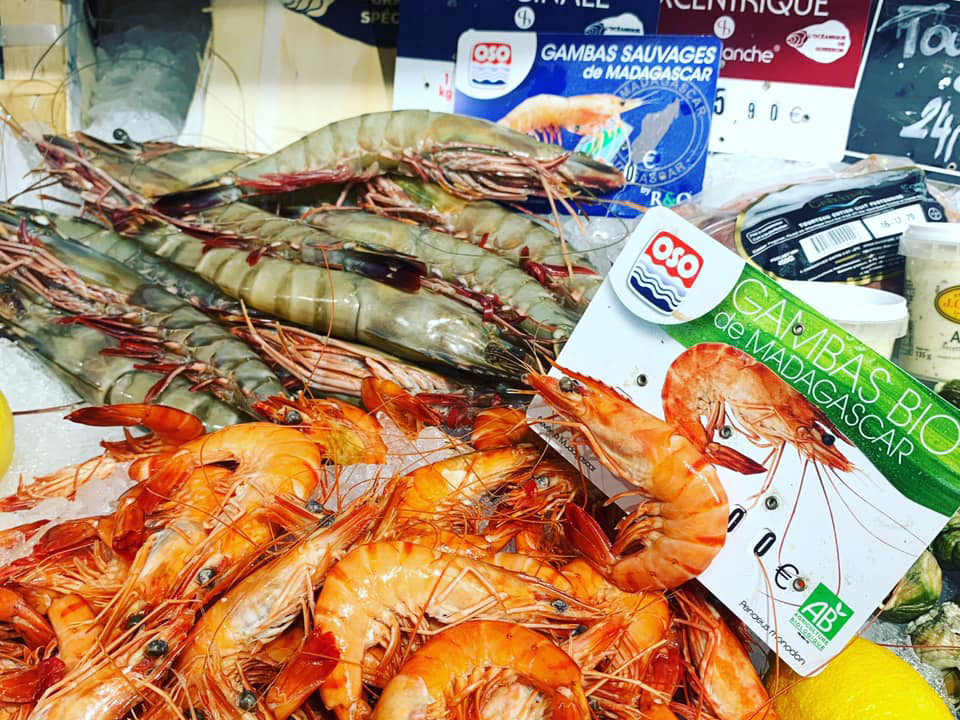
Before transitioning to Pacific white shrimp, the big markets for black tiger shrimp—besides Japan, the Middle East, and China—were the US and northern Europe. These were markets for HLSO and peeled products. However, with the rise of the cheaper Pacific white shrimp, the largest part of those markets have accepted this species as a more affordable alternative. The US market for black tiger shrimp has almost entirely disappeared and today’s northern European market is largely limited to the food service industry and some minor pockets of retail in Belgium and Germany. The largest part of the food service industry is Asian; customers who recognize the premium character of the species. However, even in this segment, Heiko Lenk and Rogier Speelman of Lenk Frozen Foods and Fisherman’s Choice, respectively, argue that the willingness to pay a premium in this potentially large market segment is limited. As soon as the price difference exceeds $1/kg, even the most loyal black tiger shrimp buyer will consider switching species in favor of the cheaper Pacific white shrimp.
The main message of the market reflections panel—confirmed by Jeff Stern, Co-President of Censea, the largest black tiger shrimp importer and distributor in the US—was that unless black tiger shrimp producers in Asia manage to stay under that $1 price difference with Pacific white shrimp, they shouldn’t count on market acceptance in northern Europe or the US. But even if they succeed, it won’t be easy to find a market for black tiger shrimp volumes exceeding 500,000 MT in northern Europe and the US alone. Producers in Asia may need to consider traditional black tiger shrimp markets in Japan and the Middle East, but especially also at China, to absorb their projected surge of production at prices that indeed provide the smaller scale farmers with an option to continue making a living of farming shrimp.

CONCLUSION
This blog is not an endorsement or encouragement of a transition back from Pacific white shrimp to black tiger shrimp. Neither is it a complete analysis of or outlook on a possible scenario of black tiger shrimp in Asia, as the situation is too nuanced and complex to discuss in detail here. Instead, it’s my realization that for part of the shrimp farmers in Asia a resilient industry lies not in more efficient Pacific white shrimp production and supply chains, but in fine-tuning the fitting farmer-system-species combination.
While acknowledging that we will likely see a surge of black tiger shrimp production in India and Indonesia, the resurrection might be very short-lived if the producers, feed companies, processors, and their overseas buyers don’t work together to develop the market. For the revival of black tiger shrimp to be successful, we may not only need to look at the suitable farmer-system-species combination but extend it with the right specification-market combination.

If the resurrection becomes long-lived, a more diverse shrimp farming industry in Asia is possible in which extensive and semi-intensive black tiger shrimp production as well as intensive and super-intensive Pacific white shrimp production have their place. And in which farmers, their input suppliers, and their domestic and overseas buyers will continue to make a decent living.